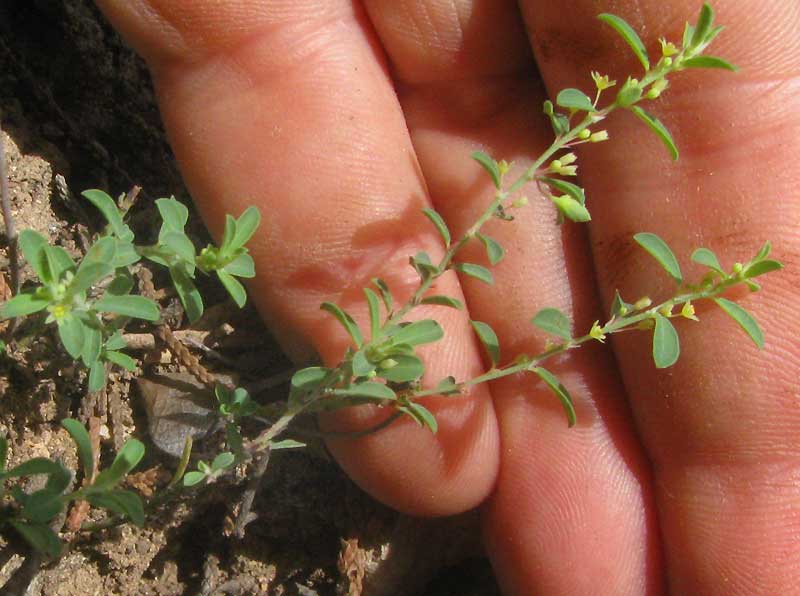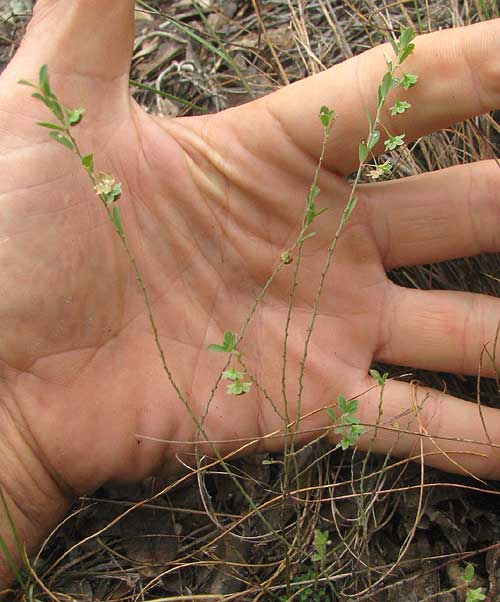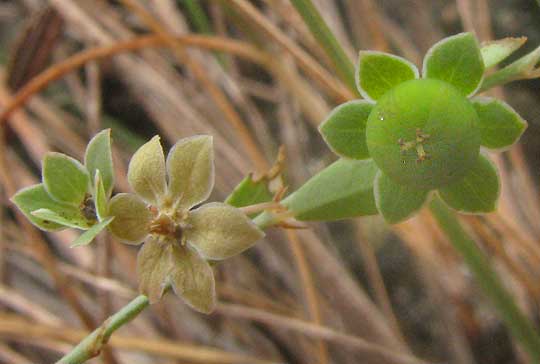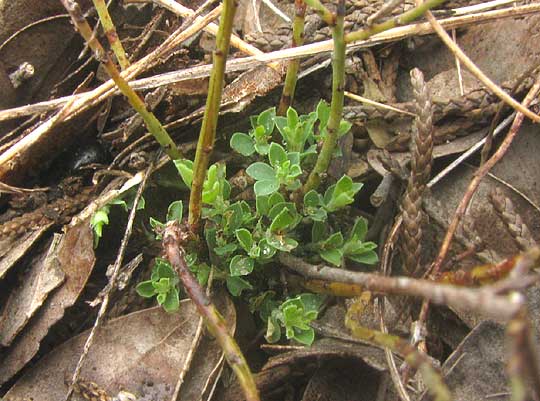Excerpts from Jim Conrad's
Naturalist Newsletter

from the September 22, 2013 Newsletter issued from the Frio Canyon Nature Education Center in the valley of the Dry Frio River in northern Uvalde County, southwestern Texas, on the southern border of the Edwards Plateau; elevation ~1750m (~5750 ft); N29.62°, W99.86°; USA
SMARTWEED LEAF-FLOWER
A tiny wildflower was rooted perilously on the Dry Frio River's dry, gravely streambed in a spot bound to be washed away during our first good rain. That's it above. A close-up of one of the yellowish, miniscule flowers is shown below:

The little flower's calyx and corolla are merged into one "floral envelope," or perianth, so instead of having petals and sepals it's said to have "tepals." And it has six tepals, which is unusual for a dicot. It's also unusual that the flower bears only three stamens with yellow, pollen-producing anthers. Something else striking is that at the base of each leaf petiole there's a conspicuous, white, triangular-shaped stipule.
These field marks suggest a member of the Smartweed or Buckwheat Family, the Polygonaceae, but when I began looking at members of that family found in Texas absolutely nothing similar to it turned up. Happily, in the midst of my ID struggles, that's when I happened to be exchanging letters with Texas botanist Bill Carr of Austin, so I cheated and sent the picture to him.
"PHYLLANTHUS POLYGONOIDES," he shot back, a plant sometimes known as the Smartweed Leaf-flower. The genus Phyllanthus often is placed in the Euphorbia or Poinsettia Family, but lately many botanists are so struck by its peculiarities that it's been given its own family, the Leaf-flower Family, the Phyllanthaceae. The 2000 or so members of that family are mostly tropical and subtropical. The polygonoides species name is gratifying because it means "like the smartweed," and I'd been looking in the Smartweed Family, so I'm not the only one to be tricked by this herb.
Our little Smartweed Leaf-flower doesn't give a hint as to why it's called a leaf-flower. However, we've run into Phyllanthus species in Mexico where the name leaf-flower makes more sense. You can see a picture of one of them at http://www.backyardnature.net/chiapas/phyllant.htm.
In the middle picture on that page notice how flowers arise from what appears to be the midrib, or rachis, of a pinnately compound leaf. In fact, the "leaf" from which the flowers arise actually is a stem with many simple leaves, so flowers actually are arising singly in a normal way, each one emerging from where the leaf attaches to the stem. A very unusual feature of this plant family, then, is that ultimate leaf branches often look like pinnate leaves.
Our Smartweed Leaf-flower doesn't display this feature. However, as a member of a mostly tropical and subtropical family, our little herb is sort of pioneer settling on the family's outer border with the Temperate Zone, and it's often the case that species on the fringes of a group's normal distribution area display adaptive features unusual for that group.
Smartweed Leaf-flower is so small and obscure that not much is known about its medicinal properties, though Don Chus, the Tzotzil-speaking man in the picture at the above link said that his plant was used medicinally to break up kidney stones. In Indian ayurvedic medicine, various herbaceous Phyllanthus species are prescribed for jaundice, gonorrhea and diabetes as well as for making poultices for skin problems. Infusions from young shoots are used to treat chronic dysentery.
from the December 8, 2013 Newsletter issued from the Frio Canyon Nature Education Center in the valley of the Dry Frio River in northern Uvalde County, southwestern Texas, on the southern border of the Edwards Plateau; elevation ~1750m (~5750 ft); N29.62°, W99.86°; USA
LEAF-FLOWER WITH LEAF-FLOWERS
Back in September we couldn't figure out why leaf-flowers are leaf-flowers, since our plant's flowers were normal-looking blossoms. Now that the plant's flowers have been replaced by fruits, it's easy to see why leaf-flowers are called leaf-flowers. Below, you can see the plant today, adorned with what appear to be flowers but which really are mature fruits with leafy-textured calyxes:

A close-up of a spherical, green fruit subtended by six green, white-margined sepals is shown below:

By now we've seen so many fruits similar to this that we know it can't belong to any plant family other than that of the ubiquitous Euphorbia or Poinsettia Family, the Euphorbiaceae.
In the above picture, to the left of the green fruit, there's a tan-colored, flower-like item lacking a fruit. That's the remains of a male flower, for flowers are unisexual in the Euphorbia Family. Notice that atop the green fruit resides a three-forked style, with each fork notched at its tip, exactly as we've seen on several other species in this family.
In September, Smartweed Leaf-flower plants looked so small and fragile that one would have guessed that they are herbaceous annuals. However, now at the plants' bases semi-woody stems arise from tiny, green sprouts preparing to emerge next spring, as shown below:
